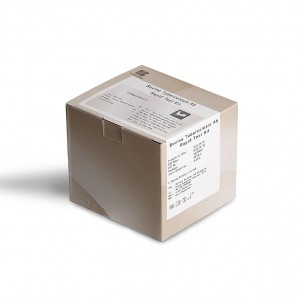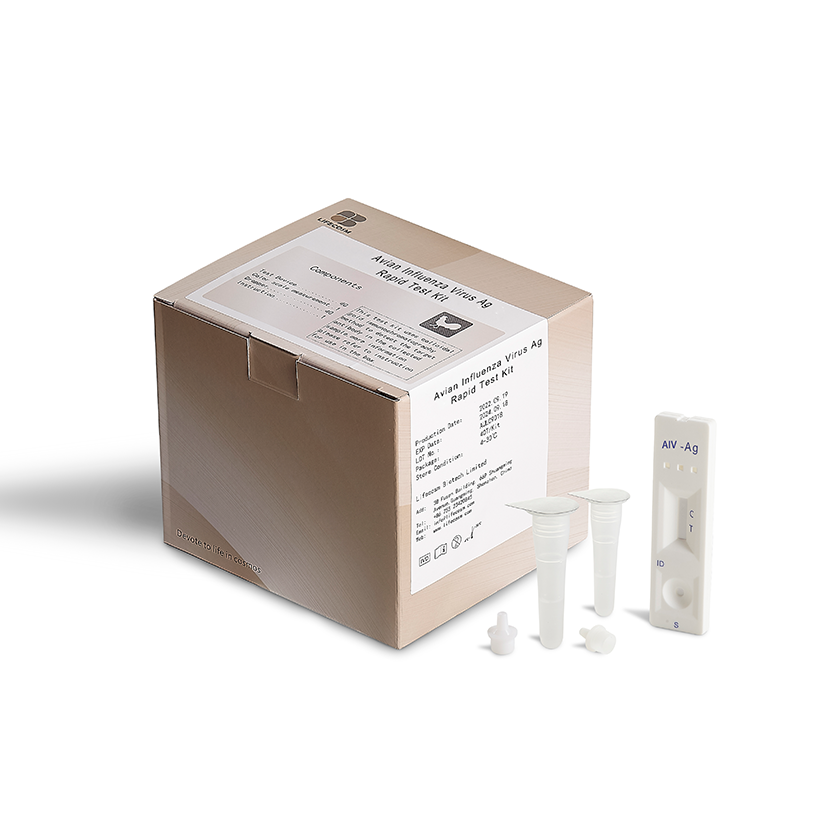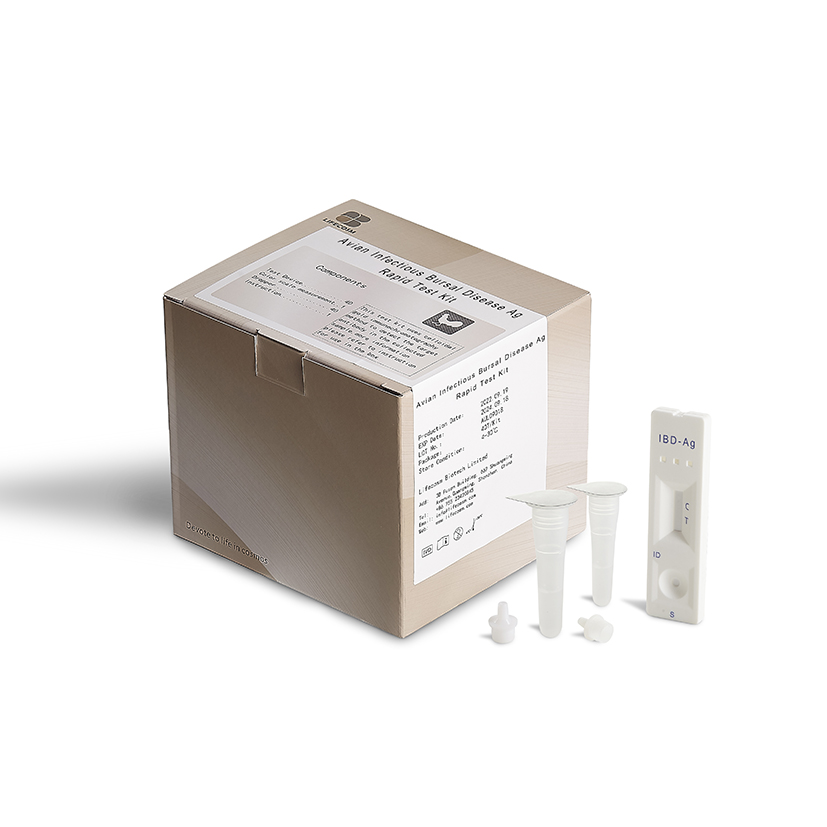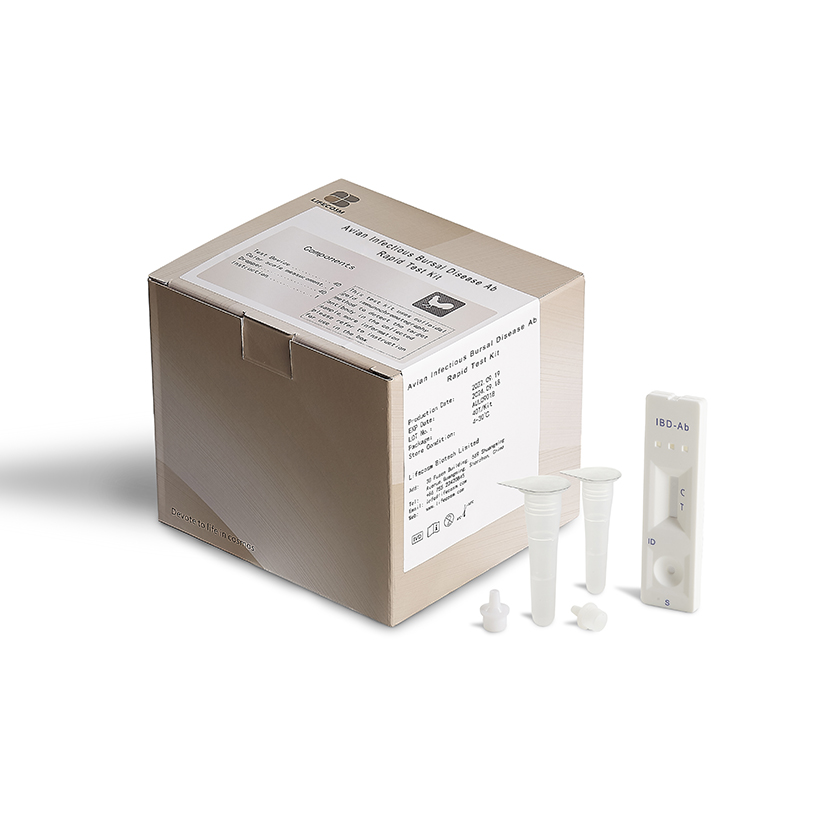
Products
Lifecosm Rapid Bovine Tuberculosis Ab Test Kit for veterinary diagnostic test
Rapid Bovine Tuberculosis Ab Test Kit
|
Rapid Bovine Tuberculosis Ab Test Kit |
|
| Summary | Detection of specific Antibody of Bovine Tuberculosis within 15 minutes |
| Principle | One-step immunochromatographic assay |
| Detection Targets | Bovine Tuberculosis Antibody |
| Sample | Serum |
| Reading time | 10~ 15 minutes |
| Quantity | 1 box (kit) = 10 devices (Individual packing) |
| Contents | Test kit, Buffer bottles, Disposable droppers, and Cotton swabs |
|
Caution |
Use within 10 minutes after openingUse appropriate amount of sample (0.1 ml of a dropper)
Use after 15~30 minutes at RT if they are stored under cold circumstances Consider the test results as invalid after 10 minutes |
Information
Mycobacterium bovis (M. bovis) is a slow-growing (16- to 20-hour generation time) aerobic bacterium and the causative agent of tuberculosis in cattle (known as bovine TB). It is related to Mycobacterium tuberculosis, the bacterium which causes tuberculosis in humans. M. bovis can jump the species barrier and cause tuberculosis-like infection in humans and other mammals.
Zoonotic tuberculosis
The infection of humans with M. bovis is referred to as zoonotic tuberculosis. In 2017, the World Health Organization (WHO), World Organization for Animal Health (OIE), Food and Agriculture Organization (FAO), and The International Union Against Tuberculosis and Lung Disease (The Union), published the first Roadmap for Zoonotic Tuberculosis, recognizing zoonotic tuberculosis as a prominent global health problem.[45] The main route of transmission is through the consumption of unpasteurized milk or other dairy products, although transmission via inhalation and via consumption of poorly cooked meat has also been reported. In 2018, based on the most recent Global Tuberculosis Report, an estimated 142,000 new cases of zoonotic tuberculosis, and 12,500 deaths due to the disease occurred. Cases of zoonotic tuberculosis have been reported in Africa, the Americas, Europe, the Eastern Mediterranean, and the Western Pacific. Human zoonotic tuberculosis cases are linked to the presence of bovine tuberculosis in cattle, and regions without adequate disease control measures and/or disease surveillance are at higher risk. It is difficult to clinically distinguish zoonotic tuberculosis from tuberculosis caused by Mycobacterium tuberculosis in people, and the current most commonly used diagnostics cannot effectively distinguish between M. bovis and M. tuberculosis, which contributes to an underestimation of total cases worldwide. Controlling this disease requires animal health, food safety, and human health sectors to work together under a One Health approach (multi-disciplinary collaborations to improve the health of animals, people, and the environment).[49]
The 2017 Roadmap identified ten priority areas for addressing zoonotic tuberculosis, which include collecting more accurate data, improving diagnostics, closing research gaps, improving food safety, reducing M. bovis in animal populations, identifying risk factors for transmission, increasing awareness, developing policies, implementing interventions, and increasing investments.To align with goals outlined in the Stop TB Partnership Global Plan to End TB 2016-2020, The Roadmap outlines specific milestones and goals to be met within this time frame.
Symptoms
There are many subtypes of avian influenza viruses, but only some strains of five subtypes have been known to infect humans: H5N1, H7N3, H7N7, H7N9, and H9N2. At least one person, an elderly woman in Jiangxi Province, China, died of pneumonia in December 2013 from the H10N8 strain. She was the first human fatality confirmed to be caused by that strain.
Most human cases of the avian flu are a result of either handling dead infected birds or from contact with infected fluids. It can also be spread through contaminated surfaces and droppings. While most wild birds have only a mild form of the H5N1 strain, once domesticated birds such as chickens or turkeys are infected, H5N1 can potentially become much more deadly because the birds are often in close contact. H5N1 is a large threat in Asia with infected poultry due to low hygiene conditions and close quarters. Although it is easy for humans to contract the infection from birds, human-to-human transmission is more difficult without prolonged contact. However, public health officials are concerned that strains of avian flu may mutate to become easily transmissible between humans.
Spreading of H5N1 from Asia to Europe is much more likely caused by both legal and illegal poultry trades than dispersing through wild bird migrations, being that in recent studies, there were no secondary rises in infection in Asia when wild birds migrate south again from their breeding grounds. Instead, the infection patterns followed transportation such as railroads, roads, and country borders, suggesting poultry trade as being much more likely. While there have been strains of avian flu to exist in the United States, they have been extinguished and have not been known to infect humans.
Order Information
| Product Code | Product Name | Pack | Rapid | ELISA | PCR |
| Bovine tuberculosis | |||||
| RE-RU04 | Bovine Tuberculosis Ab Test Kit (ELISA) | 192T |  |
||
| RC-RU04 | Bovine Tuberculosis Ab Rapid Test Kit | 20T |  |










